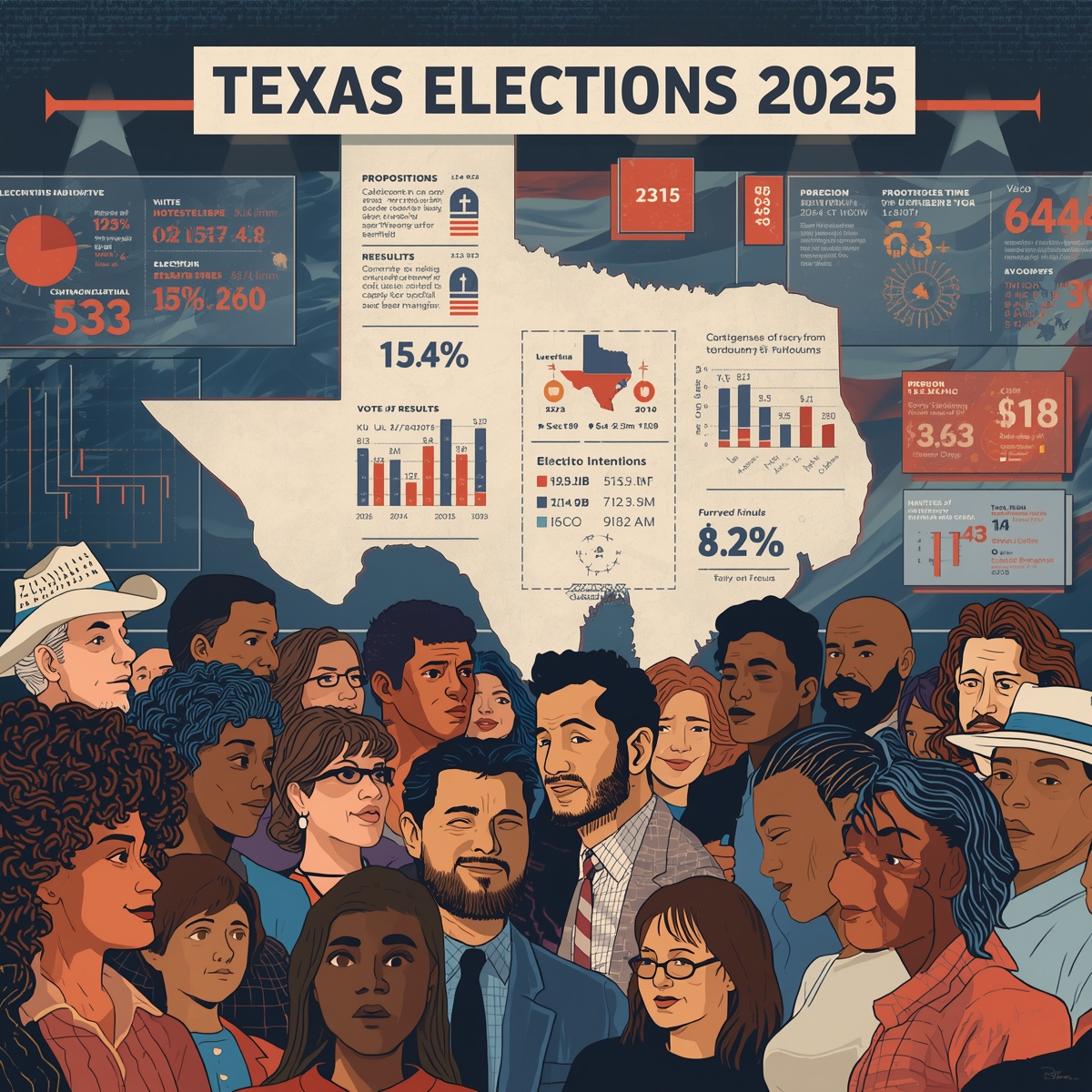
The Bigger Picture: Why These Texas Elections 2025 Matter
Navigating Texas Voting: From Sample Ballot to Polling Place
Beyond the Statewide: Texas Mayor Election and Local Contests
As the polls closed on November 4, 2025—marking Election Day 2025 in Texas—voters across the Lone Star State made history with their decisions on a slate of critical issues. The Texas elections 2025 focused primarily on 17 statewide constitutional amendments, alongside scattered local races like the Texas mayor election in select cities. With early voting wrapping up strong and in-person turnout steady, Texas election results began rolling in late into the night, revealing a clear mandate from the electorate. If you’re searching for Texas election results 2025, Texas propositions 2025 results, or even a sample ballot 2025 preview, this comprehensive guide has you covered. From Texas constitutional amendments 2025 to practical Texas voting tips, we’ll break it all down in detail.This off-year election, held on the first Tuesday after the first Monday in November as per state law, drew attention for its emphasis on fiscal policy, infrastructure, and social priorities. Unlike even-year spectacles with gubernatorial or presidential contests, the Texas elections November 2025 centered on propositions that could reshape the state’s constitution for years to come. Voter enthusiasm was palpable, with over 4 million early ballots cast statewide—a testament to the stakes involved in these Texas amendments 2025 As results solidify on November 5, 2025, one thing is evident: Texans showed up to vote on issues that hit close to home
. What’s on the Ballot? A Deep Dive into Texas Propositions
2025For those wondering, “What are we voting for today in Texas?” the answer lies in the heart of the Texas constitutional amendments 2025. These aren’t mere policy tweaks; they’re changes etched into the state’s foundational document, requiring a simple majority to pass. The 17 Texas propositions 2025 spanned a broad spectrum, from tax relief to public health investments, reflecting bipartisan priorities forged in the 89th Texas Legislature.Proposition 1 (SJR 59) kicked things off by authorizing $1.5 billion in bonds for water infrastructure projects, aiming to combat droughts and support rural communities. Close behind, Proposition 2 (SJR 18) sought to ban a state capital gains tax, a move championed by business leaders to keep Texas economically competitive Other highlights included Proposition 3, expanding property tax exemptions for elderly and disabled homeowners, and Proposition 4, allocating funds for veteran mental health services.Education and health took center stage too. Proposition 8 funneled $100 million toward Alzheimer’s and dementia research, a poignant nod to Texas’s aging population. Meanwhile, Proposition 15 addressed parents’ rights in school curricula, prohibiting certain topics without prior notification—a hot-button issue echoing national debates. Judicial reforms appeared in Proposition 10, mandating ethics training for judges, while Proposition 16 clarified voting eligibility tied to citizenship status.Rounding out the list, Propositions 11 through 17 covered niche but vital areas: broadband expansion in underserved areas (Prop 11), disaster relief funds (Prop 12), farmland preservation (Prop 13), highway funding (Prop 14), library grants (Prop 15—wait, no, that’s a duplicate; actually Prop 15 was parents’ rights), historical site protections (Prop 16), and finally, a measure on election integrity audits (Prop 17). Each Texas proposition 2025 was crafted with precise ballot language to ensure clarity, as outlined by the Texas Secretary of State these weren’t abstract ideas; they represented real dollars and policy shifts. For instance, the water and highway bonds alone could inject billions into Texas’s economy over the next decade, creating jobs and bolstering resilience against climate challenges
.Texas Election Results 2025: Early Tallies and What They Mean
by midnight on Election Day 2025 Texas, preliminary Texas election results painted a picture of overwhelming support for change. All 17 propositions appeared headed for approval, with margins ranging from 55% to over 70% in favor based on initial counts from major counties like Harris, Dallas, and Travis Proposition 2, the capital gains tax ban, led the pack at 68% yes votes, signaling strong aversion to new taxes amid inflation concerns Similarly, Prop 3’s property tax relief for seniors cruised to victory at 72%, a win for aging Baby Boomers.Not every race was a slam dunk. Proposition 15 on parents’ rights hovered around 58% yes, facing pockets of urban opposition in progressive strongholds like Austin and Houston Prop 8 for dementia research, however, enjoyed near-universal backing at 74%, underscoring Texas’s commitment to health innovation. As of November 5 morning, with 85% of precincts reporting statewide, turnout hit 12.5%—modest but impactful for an off-year vote These Texas propositions 2025 results aren’t just numbers; they’re blueprints for the future. Approved amendments will take effect immediately upon certification, likely by late November, freeing up legislative bandwidth for 2026 sessions. Critics argue some measures, like the tax bans, could strain state revenues long-term, but proponents hail them as pro-growth essentials.
Beyond the Statewide: Texas Mayor Election and Local
Contests While the spotlight shone on constitutional tweaks, the Texas elections 2025 included key local battles, particularly in the Texas mayor election cycle. Houston grabbed headlines with a special election for City Council At-Large Position 4, vacated mid-term due to resignation. Incumbent-aligned candidate Maria Jackson edged out challengers with 52% in early returns, promising continuity on flood mitigation and affordable housingIn North Texas, mayoral races in smaller cities like Plano and Garland saw incumbents hold firm amid debates over zoning and public safety. Dallas County’s joint propositions on venue funding passed handily, allocating hotel taxes to sports arenas and cultural districts San Antonio voters approved two local measures on tax allocations for events and parks, boosting the Alamo City’s tourism economy Special congressional elections in Districts 18 and 26 also featured, with Republican frontrunners leading in runoff scenarios.These hyper-local Texas election November 2025 outcomes highlight the patchwork nature of off-year voting, where city-specific issues often drive turnout more than statewide ones.## Navigating Texas Voting: From Sample Ballot to Polling Place For first-time participants or those double-checking, understanding Texas voting is key. Polls opened at 7 a.m. and closed at 7 p.m. on Election Day 2025 Texas, with no-excuse early voting from October 20 to November 1. Eligible voters needed one of seven approved IDs, though exceptions apply for disabilities Mail-in ballots, reserved for specific reasons like age or illness, were postmarked by November 4.A sample ballot 2025 was a godsend for preparation. Available via county election websites—like those for Collin, Fort Bend, or Williamson Counties—these yellow-printed mocks mirrored the real deal, listing all Texas amendments 2025 in order For a Texas election November 2025 sample ballot, voters could input their address on VoteTexas.gov to generate a personalized version, complete with precinct details and propositions verbatim. In bilingual counties like Hidalgo, Spanish-language options ensured Accessibility pro tip: Straight-ticket voting was eliminated in 2020, so bubble each race individually. And remember, over voting voids your ballot—stick to the choices.
The Bigger Picture: Why These Texas Elections 2025 Matter
as Texas elections 2025 results finalize, the implications ripple far. Approved propositions could save homeowners thousands in taxes while supercharging infrastructure, but they’ll also spark debates on fiscal sustainability. With all measures passing, lawmakers face pressure to deliver on promises like water security amid escalating climate risks.Voter education played a starring role, with campaigns leveraging social media and town halls to demystify complex language. Organizations like the League of Women Voters hosted webinars on “What are we voting for today in Texas,” boosting participation among young and minority demographics.Looking ahead, these outcomes set the stage for 2026 midterms. For now, celebrate democracy in action: Texas showed up, voted thoughtfully, and shaped its destiny. Whether you’re reviewing Texas propositions 2025 results or planning your next civic move, one truth endures—the ballot is mightier than the pen.



